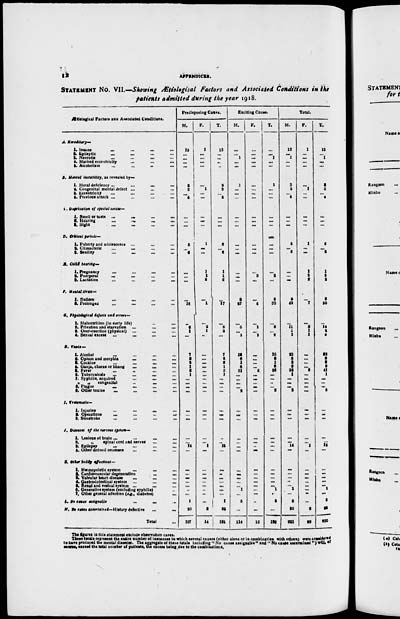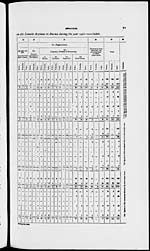Medicine - Mental health > 1907-1924 - Note on the lunatic asylums in Burma > 1907-1921 - Lunatic asylums Burma 1907-21 > Note on the lunatic asylums in Burma for the year 1918
(300) Page 12
Download files
Individual page:
Thumbnail gallery: Grid view | List view

12 APPENDICES.
STATEMENT No. VII.—Showing Ætiologcal Factors and Associated Conditions in the
patients admitted during the year 1918.
|
Ætiological Factors and Associated Conditions. |
Predisposing Cause. |
Exciting Cause. |
Total. |
||||||
|
M. |
F. |
T. |
M. |
F. |
T. |
M. |
F. |
T. |
|
|
A. Hereditary— |
|||||||||
|
1. Insane ... ... ... ... |
12 |
1 |
13 |
... |
... |
... |
12 |
1 |
13 |
|
2. Epileptic ... ... ... ... |
... |
... |
... |
... |
... |
... |
... |
... |
... |
|
3. Neurotic ... ... ... ... |
... |
... |
... |
1 |
... |
1 |
1 |
... |
1 |
|
4. Marked eccentricity ... ... ... |
... |
... |
... |
... |
... |
... |
... |
... |
... |
|
5. Alcoholism ... ... ... ... |
... |
... |
... |
... |
... |
... |
... |
... |
... |
|
B. Menial instability, at revealed by— |
|||||||||
|
1. Moral deficiency ... ... ... ... |
2 |
... |
2 |
1 |
... |
1 |
3 |
... |
3 |
|
2. Congenital mental defect ... ... ... |
2 |
1 |
3 |
... |
... |
... |
2 |
1 |
3 |
|
3. Eccentricity ... ... ... ... |
... |
... |
... |
... |
... |
... |
... |
... |
... |
|
4. Previous attack ... ... ... ... |
4 |
... |
4 |
... |
... |
... |
4 |
... |
4 |
|
C. Deprivation of special senses— |
|||||||||
|
1. Smell or taste ... ... ... ... |
... |
... |
... |
... |
... |
... |
... |
... |
... |
|
2. Hearing ... ... ... ... |
... |
... |
... |
... |
... |
... |
... |
... |
... |
|
3. Sight ... ... ... ... |
... |
... |
... |
... |
... |
... |
... |
... |
... |
|
D. Critical periods— |
|||||||||
|
1. Puberty and adolescence ... ... ... |
5 |
1 |
6 |
... |
... |
... |
5 |
1 |
6 |
|
2. Climacteric ... ... ... ... |
... |
... |
... |
... |
... |
... |
... |
... |
... |
|
3. Senility ... ... ... ... |
6 |
... |
6 |
... |
... |
... |
6 |
... |
6 |
|
E. Child bearing— |
|||||||||
|
1. Pregnancy ... ... ... ... |
... |
1 |
1 |
... |
... |
... |
... |
1 |
1 |
|
2. Puerperal ... ... ... ... |
... |
1 |
1 |
... |
2 |
2 |
... |
2 |
2 |
|
3. Lactation ... ... ... ... |
... |
2 |
2 |
... |
... |
... |
... |
2 |
2 |
|
F. Mental stress— |
|||||||||
|
1. Sudden ... ... ... ... |
... |
... |
... |
9 |
... |
9 |
9 |
... |
9 |
|
2. Prolonged ... ... ... ... |
16 |
1 |
17 |
27 |
6 |
33 |
43 |
7 |
50 |
|
G. Physiological defects and errors— |
|||||||||
|
1. Malnutrition (in early life) ... ... |
... |
... |
... |
... |
... |
... |
... |
... |
... |
|
2. Privation and starvation ... ... ... |
6 |
2 |
8 |
5 |
1 |
6 |
11 |
3 |
14 |
|
3. Over-exertion (physical) ... ... ... |
1 |
1 |
2 |
... |
... |
... |
1 |
1 |
2 |
|
4. Sexual excess ... ... ... ... |
... |
... |
... |
1 |
1 |
2 |
1 |
1 |
2 |
|
H. Toxic— |
|||||||||
|
1. Alcohol ... ... ... ... |
7 |
... |
7 |
16 |
... |
16 |
23 |
... |
23 |
|
2. Opium and morphia ... ... ... |
9 |
... |
9 |
6 |
... |
6 |
8 |
... |
8 |
|
3. Cocaine ... ... ... ... |
2 |
... |
2 |
1 |
... |
1 |
3 |
... |
3 |
|
4. Ganja, charas or bhang ... ... ... |
1 |
... |
1 |
8 |
... |
8 |
9 |
... |
9 |
|
5. Fever ... ... ... ... |
5 |
... |
5 |
31 |
5 |
36 |
36 |
5 |
41 |
|
6. Tuberculosis ... ... ... ... |
1 |
... |
1 |
... |
... |
... |
1 |
... |
1 |
|
7. Syphilis, acquired ... ... ... |
... |
... |
... |
... |
... |
... |
... |
... |
... |
|
„ „ congenital ... ... ... |
... |
... |
... |
... |
... |
... |
... |
... |
... |
|
8. Plague ... ... ... ... |
... |
... |
... |
... |
... |
... |
... |
... |
... |
|
9. Other toxins ... ... ... ... |
... |
... |
... |
2 |
... |
2 |
2 |
... |
2 |
|
I. Traumatic— |
|||||||||
|
1. Injuries ... ... ... ... |
... |
... |
... |
... |
... |
... |
... |
... |
... |
|
2. Operations ... ... ... ... |
... |
... |
... |
... |
... |
... |
... |
... |
... |
|
3. Sunstroke ... ... ... ... |
... |
... |
... |
... |
... |
... |
... |
... |
... |
|
J. Diseases of the nervous system— |
|||||||||
|
1. Tesions of brain ... ... ... ... |
... |
... |
... |
... |
... |
... |
... |
... |
... |
|
2. „ spinal cord and nerves ... ... |
... |
... |
... |
... |
... |
... |
... |
... |
... |
|
3. Epilepsy ... ... ... ... |
14 |
1 |
15 |
... |
... |
... |
14 |
1 |
15 |
|
4. Other defined neuroses ... ... ... |
... |
... |
... |
... |
... |
... |
... |
... |
... |
|
K. Other bodily affections— |
|||||||||
|
1. Hæmopoletic system ... ... ... |
... |
... |
... |
... |
... |
... |
... |
... |
... |
|
2. Cardio-vascular degeneration ... ... ... |
... |
... |
... |
... |
... |
... |
... |
... |
... |
|
3. Valvular heart disease ... ... ... |
... |
... |
... |
... |
... |
... |
... |
... |
... |
|
4. Gastro-intestinal system ... ... ... |
... |
... |
... |
... |
... |
... |
... |
... |
... |
|
5. Renal and vesical system ... ... ... |
... |
... |
... |
... |
... |
... |
... |
... |
... |
|
6. Generative system (excluding syphilis) ... |
... |
... |
... |
... |
... |
1 |
1 |
... |
1 |
|
7. Other general affection (e.g., diabetes) ... |
... |
... |
... |
... |
... |
... |
... |
... |
... |
|
L. No cause assignable ... ... ... |
1 |
... |
1 |
5 |
.. |
5 |
6 |
... |
6 |
|
M. No cause ascertained — History defective ... ... |
20 |
2 |
22 |
... |
... |
... |
20 |
2 |
22 |
|
Total ... |
107 |
14 |
121 |
114 |
15 |
129 |
221 |
29 |
950 |
The figures in this statement exclude observation cases.
These totals represent the entire number of instances in which several causes (either alone or in combination with others) were considered
to have produced the mental disorder. The aggregate of these totals including "No cause assignable" and "No cause ascertained") will, of
course, exceed the total number of patients, the excess being due to the combinations.
Set display mode to: Large image | Zoom image | Transcription
Images and transcriptions on this page, including medium image downloads, may be used under the Creative Commons Attribution 4.0 International Licence unless otherwise stated. ![]()
| India Papers > Medicine - Mental health > Note on the lunatic asylums in Burma > Lunatic asylums Burma 1907-21 > Note on the lunatic asylums in Burma for the year 1918 > (300) Page 12 |
|---|
| Permanent URL | https://digital.nls.uk/83980883 |
|---|




